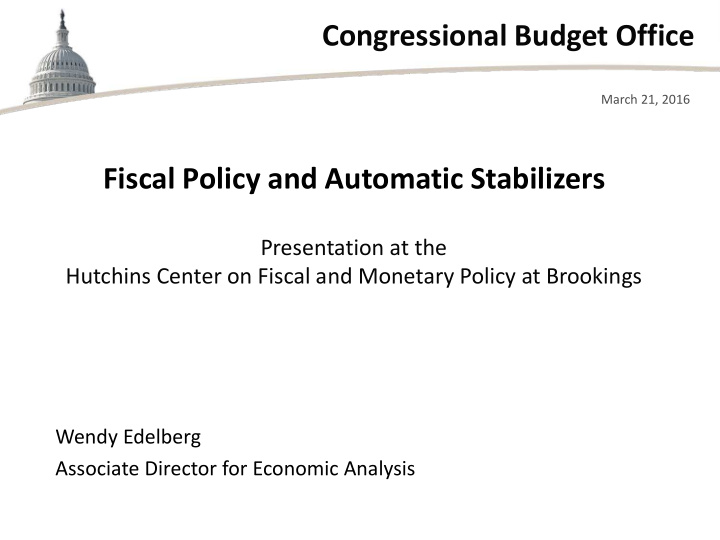



Congressional Budget Office March 21, 2016 Fiscal Policy and Automatic Stabilizers Presentation at the Hutchins Center on Fiscal and Monetary Policy at Brookings Wendy Edelberg Associate Director for Economic Analysis
If current laws remain generally the same, growing deficits are projected to raise federal debt held by the public to 86 percent of gross domestic product (GDP) by 2026—up from 74 percent at the end of 2015 and a little more than twice the average of the past five decades. 1 CONGRESSIONAL BUDGET OFFICE
Total Deficits or Surpluses Percentage of GDP 2 CONGRESSIONAL BUDGET OFFICE
Federal Debt Held by the Public Percentage of GDP 3 CONGRESSIONAL BUDGET OFFICE
High and rising debt has a number of consequences: Lawmakers would have less flexibility to use • tax and spending policies to respond to unexpected challenges. Federal spending on interest payments would • rise substantially when interest rates increased from their current levels to more typical ones. The likelihood of a fiscal crisis in the United • States would increase. 4 CONGRESSIONAL BUDGET OFFICE
There would be a greater risk that investors • would become unwilling to finance the government’s borrowing needs unless they were compensated with very high interest rates; if that happened, interest rates on federal debt would rise suddenly and sharply. Because federal borrowing reduces total • saving in the economy over time, the nation’s capital stock would ultimately be smaller than it would be if debt was smaller, and productivity and total wages would be lower. 5 CONGRESSIONAL BUDGET OFFICE
Over the next few years, CBO anticipates a near elimination of slack in the economy, as evidenced by the closing gap between GDP and potential GDP. 6 CONGRESSIONAL BUDGET OFFICE
GDP and Potential GDP Trillions of 2009 Dollars 7 CONGRESSIONAL BUDGET OFFICE
CBO expects that automatic stabilizers will provide less economic stimulus over the next few years. Automatic stabilizers are the automatic increases in revenues and decreases in outlays in the federal budget that occur when the economy strengthens, and the opposite changes that occur when the economy weakens. 8 CONGRESSIONAL BUDGET OFFICE
Contribution of Automatic Stabilizers to Budget Deficits and Surpluses Percentage of GDP 9 CONGRESSIONAL BUDGET OFFICE
Contribution of Automatic Stabilizers to the Deficit as a Share of Potential GDP Percent After Four Quarters After Eight Quarters Beginning of Recession 1969, Fourth Quarter 1.4 1.1 1973, Fourth Quarter 1.9 2.6 1980, First Quarter 0.5 1.8 1981, Third Quarter 1.6 1.1 1990, Third Quarter 1.1 1.0 2001, First Quarter 0.9 1.3 2007, Fourth Quarter 1.2 2.1 10 CONGRESSIONAL BUDGET OFFICE
Budget Deficits and Surpluses With and Without Automatic Stabilizers Percentage of GDP 11 CONGRESSIONAL BUDGET OFFICE
For more information, see: Congressional Budget Office, The Budget and Economic Outlook: 2016 to 2026 (January 2016), www.cbo.gov/publication/49892. Frank Russek and Kim Kowalewski, How CBO Estimates Automatic Stabilizers , Working Paper 2015-07 (Congressional Budget Office, November 2015), www.cbo.gov/publication/51005. 12 CONGRESSIONAL BUDGET OFFICE
Recommend
More recommend